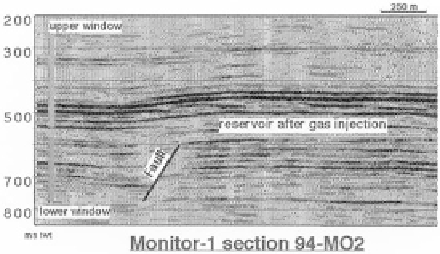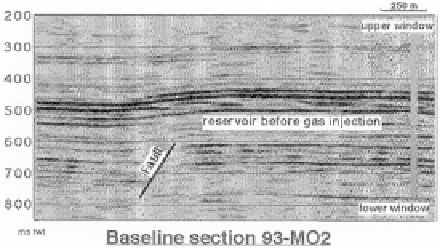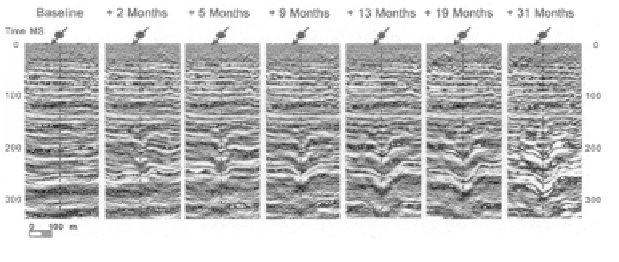Geology Reference
In-Depth Information
The primary properties of the reservoir which change
with time as hydrocarbon extraction proceeds are
the pore fluid pressure, the nature of the pore fluids, and
the temperature. Each of these may have an effect on the
seismic response. Changes in fluid pressure will affect the
state of stress in the rock matrix combined with temper-
ature, will directly affect factors such as the exsolution of
gas from hydrocarbon fluids. That these features can be
observed in seismic data has been tested directly by large-
scale experiments in producing fields. In some cases gas
has been directly pumped into permeable formations to
displace pore water, and repeat seismic surveys conduct-
ed to monitor the effect (Fig. 4.41). There are also now
well-documented case studies of clear location of the
more complex effect of steam-flood of reservoirs (Fig.
4.42). In this case pumping of steam into a reservoir has
a complex effect of liberating gas dissolved in oil, con-
densing to form water, and also replacing the oil and gas
by uncondensed steam.The figure shows the observable
seismic effects of this action over 31 months. The data
can be modelled to show that the seismic monitoring is
allowing real-time study of the fluid flow in the reservoir
( Jack 1997).This ability to monitor producing reservoirs
has major importance in allowing sophisticated control
of reservoir engineering and production operations.
The economic importance of 4D seismic surveying
to the oil industry is apparent. Increasing the oil
recovery from a producing oilfield increases the financial
return on the huge investment needed to establish a
new field and its infrastructure. Relative to this, a 4D
seismic survey at perhaps $30 m represents only a mar-
ginal cost. Plans are actively being developed to install
permanent seismic recording instrumentation over oil-
fields to facilitate repeat surveys. If all the recording
equipment is permanently installed, although this is a
large initial expense, much of the difficulty in recording
later directly comparable datasets is removed, and only a
seismic source is needed.The future prospect is of hydro-
Fig. 4.41
Repeat surveys showing the effect of gas being pumped
into a formation for storage. (a) Before gas injection; (b) after gas
injection; (c) difference section composed by subtracting (b) from
(a). (From Jack 1997.)
Fig. 4.42
Seismic sections from repeated
3D seismic surveys across an oilfield with
steam injection at the well marked on the
profile.With increasing duration of steam
injection the seismic velocity of the
reservoir formation changes progressively,
shown by the pull-up, then push-down in
the reflection from the base of the reservoir.
These changes are due to the changing pore
fluid with time. Duri oilfield, Indonesia.
(From Jack 1997.)





